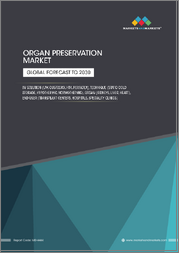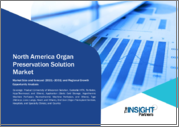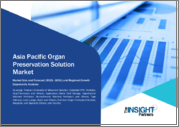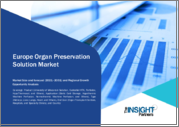
|
시장보고서
상품코드
1636685
장기 보존 용액 시장 예측(-2030년) : 장기 유형별, 솔루션 유형별, 유통 채널별, 용도별, 지역별 세계 분석Organ Preservation Solutions Market Forecasts to 2030 - Global Analysis By Organ Type (Kidneys, Liver, Heart, Lungs, Pancreas and Other Organ Types), Solution Type, Distribution Channel, Application and By Geography |
||||||
Stratistics MRC에 따르면, 세계의 장기 보존 용액 시장은 2024년에 2억 7,300만 달러를 차지했습니다. 예측 기간 동안 CAGR은 7.5%로 성장하고, 2030년에는 4억 2,130만 달러에 이를 것으로 예상되고 있습니다.
장기 보존 용액은 기증자로부터 장기를 제거하고 수령인에게 이식하는 동안 장기의 생존과 기능을 유지하도록 설계된 특수 액체입니다. 이 솔루션은 세포 손상을 방지하고 대사 활성을 감소시키고 허혈 손상으로부터 조직을 보호하며 장기가 이식에 적합한 상태를 유지할 수 있도록합니다. 일반적으로 장기를 냉각하고 장기의 열화로 이어지는 생화학적 과정을 방지함으로써 장기의 구조와 기능을 장기간 유지하는 데 매우 중요합니다.
미국 인구조사국에 따르면 2024년까지 미국 인구의 20%가 65세 이상이 된 것으로 예측되고 있으며, 장기 이식이 필요한 노화 질환의 발생률이 높아집니다.
장기부전 발생률 증가
고령화, 만성질환, 생활습관과 관련된 건강 문제 등의 요인에 의한 장기부전의 발생률 증가가 장기이식 수요를 크게 밀어 올리고 있습니다. 이것은 장기 보존 용액 시장의 성장에 박차를 가하고 있습니다. 이식에는 장기가 더 필요하기 때문에 장기 생존 가능성을 장기간 유지하는 것이 중요하며 장기 보존 기술과 솔루션의 진보로 이어져 시장 확대에 기여하고 있습니다.
장기의 가용성이 제한됩니다.
시장에서 장기의 가용성이 제한되어 있다는 것은 장기 이식 대기 시간 증가와 장기 이식을 필요로 하는 환자의 위험이 증가하는 등 중요한 과제가 되고 있습니다. 이 부족은 장기 생존율과 이식 성공률을 감소시킬 수 있는 최적이라고 할 수 없는 보존 방법에 의존하게 됩니다. 게다가, 수요가 공급을 훨씬 뛰어넘기 때문에 건강 관리 시스템은 기준에 따라 환자를 선호해야 할 필요가 없으며, 종종 약한 위치에 놓여집니다.
노인 인구 증가
노인 인구 증가는 장기 보존 용액 수요를 크게 촉진하고 있습니다. 노인은 장기 관련 건강 문제를 겪기 쉽고 장기 이식이 필요하기 때문에 효과적인 장기 보존 방법의 요구가 급증하고 있습니다. 이 인구 역학의 변화는 장기 보존 기술의 발전에 박차를 가하고 장기 이식을위한 더 긴 생존과 더 나은 결과를 보장합니다. 노화 관련 질병의 발생률 증가와 이식 솔루션의 필요성은이 시장의 주요 성장 요인입니다.
치료 비용의 높이
이 시장에서의 처치에 드는 비용은 특히 저자원 환경에서 접근성과 가용성에 큰 장벽을 초래할 수 있습니다. 이러한 비용은 고급 저장 기술의 사용을 제한하고 장기의 적시 운송 및 이식을 방해할 수 있습니다. 그 결과, 장기 이식의 성공률이 저하되고, 장기 제공 시스템의 전체적인 효율이 손상되어, 대기 시간의 장기화나 사망률의 상승으로 이어질 가능성이 있습니다.
COVID-19의 영향 :
COVID-19의 대유행은 건강과 안전에 대한 우려로 선택적 수술을 늦추거나 장기 제공을 줄임으로써 시장을 크게 혼란시켰습니다. 병원은 자원 부족에 직면했고, 장기 수송은 봉쇄와 여행 제한으로 방해받았습니다. 이러한 과제는 이식이 느려지고 환자 결과에 영향을 미치고 보존 솔루션에 대한 전반적인 수요를 줄였습니다. 게다가 유행은 이러한 중요한 의료 제품공급망을 긴장시켰습니다.
예측 기간 동안 장기 이식 분야가 최대가 될 전망
예측 기간 동안 장기 이식 분야가 가장 큰 시장 점유율을 차지할 것으로 예측됩니다. 효과적인 장기 보존은 수송 중 장기의 생존율을 유지하고 이식을 성공시키는 데 필수적입니다. 장기 공급자 증가와 함께, 특히 신장, 간, 심장과 같은 수요가 높은 장기에서는 혁신적인 보존 솔루션의 필요성이 커지고 있습니다. 시장의 성장은 이식의 성공률과 장기의 수명을 높이는 보존 방법의 발전과 밀접하게 관련되어 있습니다.
예측 기간 동안 생체 보존 분야의 CAGR이 가장 높을 것으로 예상됩니다.
생체 보존 분야는 예측 기간 동안 CAGR이 가장 높을 것으로 예상됩니다. 이 접근법은 동결보존 또는 저체온 보존 기술을 포함하며 동결이나 저온으로 인한 손상으로부터 장기를 보호합니다. 생체 보존은 장기 보존 기간을 연장하고, 허혈성 장애를 줄이고, 이식 성공률을 향상시킴으로써 장기 이식에서 더 나은 결과를 보장합니다. 그 채용 확대가 장기 보존 기술의 혁신과 시장 성장의 원동력이 되고 있습니다.
최대 점유율을 차지하는 지역
예측 기간 동안 북미가 가장 큰 시장 점유율을 차지할 것으로 예측됩니다. 이 지역은 저체온법 및 상온법을 포함한 보존 기술의 연구 개발이 활발합니다. 정부의 이니셔티브와 장기 이식에 대한 자금 지원이 시장 성장을 더욱 뒷받침하고 있습니다. 효율적인 보존 솔루션에 대한 북미의 높은 수요는 이식 성공률의 향상과 장기 거부 반응의 감소의 필요성에 의해 초래되고 있습니다.
CAGR이 가장 높은 지역 :
아시아태평양은 장기 이식에 대한 수요가 증가하고 있기 때문에 예측 기간 동안 가장 높은 성장률을 나타낼 것으로 예상됩니다. 장기 이식에 대한 수요는 장기 부전, 당뇨병 및 심장병과 같은 만성 질환의 유병률이 증가함에 따라 증가하고 있습니다. 또한 기계 관류 및 저온 보존 솔루션과 같은 고급 보존 방법의 개발로 운송 및 보존 중 장기의 생존율이 향상되었습니다.
무료 맞춤설정 제공 :
이 보고서를 구독하는 고객은 다음 무료 맞춤설정 옵션 중 하나를 사용할 수 있습니다.
- 기업 프로파일
- 추가 시장 기업의 종합적 프로파일링(3개사까지)
- 주요 기업의 SWOT 분석(3개사까지)
- 지역 세분화
- 고객의 관심에 응한 주요국 시장 추계·예측·CAGR(참고 : 타당성 확인에 따름)
- 경쟁 벤치마킹
- 제품 포트폴리오, 지리적 존재, 전략적 제휴에 기반한 주요 기업 벤치마킹
목차
제1장 주요 요약
제2장 서문
- 개요
- 이해관계자
- 조사 범위
- 조사 방법
- 데이터 마이닝
- 데이터 분석
- 데이터 검증
- 조사 접근
- 조사 정보원
- 1차 조사 정보원
- 2차 조사 정보원
- 전제조건
제3장 시장 동향 분석
- 성장 촉진요인
- 성장 억제요인
- 기회
- 위협
- 용도 분석
- 신흥 시장
- COVID-19의 영향
제4장 Porter's Five Forces 분석
- 공급기업의 협상력
- 구매자의 협상력
- 대체품의 위협
- 신규 참가업체의 위협
- 경쟁 기업간 경쟁 관계
제5장 세계의 장기 보존 용액 시장 : 장기 유형별
- 신장
- 간
- 심장
- 폐
- 췌장
- 기타 장기 유형
제6장 세계의 장기 보존 용액 시장 : 솔루션 유형별
- 정전기 방지 솔루션
- 위스콘신 대학(UW) 솔루션
- 콜린스 솔루션
- 셀시오 솔루션
- 카스트디올 솔루션
- 다이나믹 보존 솔루션
- 상온 기계 관류(NMP)
- 저체온 기계 관류(HMP)
제7장 세계의 장기 보존 용액 시장 : 유통 채널별
- 직접 판매
- 판매자/도매업체
- 온라인 판매와 전자상거래
제8장 세계의 장기 보존 용액 시장 : 용도별
- 장기 이식
- 의료 연구 개발
- 의약품 시험
- 바이오프리저베이션
- 임상 및 진단
- 장기의 회수와 운반
- 기타 용도
제9장 세계의 장기 보존 용액 시장 : 지역별
- 북미
- 미국
- 캐나다
- 멕시코
- 유럽
- 독일
- 영국
- 이탈리아
- 프랑스
- 스페인
- 기타 유럽
- 아시아태평양
- 일본
- 중국
- 인도
- 호주
- 뉴질랜드
- 한국
- 기타 아시아태평양
- 남미
- 아르헨티나
- 브라질
- 칠레
- 기타 남미
- 중동 및 아프리카
- 사우디아라비아
- 아랍에미리트(UAE)
- 카타르
- 남아프리카
- 기타 중동 및 아프리카
제10장 주요 발전
- 계약/파트너십/협업/합작투자(JV)
- 인수와 합병
- 신제품 발매
- 사업 확대
- 기타 주요 전략
제11장 기업 프로파일링
- Thermo Fisher Scientific
- Merck
- Fisher Scientific
- TSE Systems
- Sorin Group
- Eurobio Scientific
- Baxter International
- Medtronic
- Teva Pharmaceuticals
- Asahi Kasei Medical
- Hemonetics
- Organ Recovery Systems
- TransMedics
- Perfusion Solutions
- Stemcell Technologies
According to Stratistics MRC, the Global Organ Preservation Solutions Market is accounted for $273.0 million in 2024 and is expected to reach $421.3 million by 2030 growing at a CAGR of 7.5% during the forecast period. Organ preservation solutions are specialized fluids designed to maintain the viability and function of organs during the period between their removal from a donor and transplantation into a recipient. These solutions help prevent cellular damage, reduce metabolic activity, and protect tissues from ischemic injury, ensuring that the organ remains suitable for transplantation. They are critical in preserving the organ's structure and function for extended periods, typically by cooling the organ and preventing biochemical processes that could lead to organ deterioration.
According to the U.S. Census Bureau, it is projected that 20% of the U.S. population will be aged 65 and older by 2024, leading to a higher incidence of age-related diseases necessitating organ transplants.
Market Dynamics:
Driver:
Increasing incidence of organ failure
The increasing incidence of organ failure, driven by factors such as aging populations, chronic diseases, and lifestyle-related health issues, has significantly boosted the demand for organ transplantation. This, in turn, has fueled the growth of the organ preservation solutions market. As more organs are needed for transplantation, the importance of preserving organ viability for longer durations has led to advancements in preservation technologies and solutions, contributing to market expansion.
Restraint:
Limited availability of organs
The limited availability of organs in the market poses significant challenges, including increased organ transplant waiting times and heightened risks for patients in need. This scarcity leads to a reliance on suboptimal preservation methods, which may reduce organ viability and transplant success rates. Additionally, the shortage contributes to ethical concerns, as demand far exceeds supply, forcing healthcare systems to prioritize patients based on criteria, often leaving vulnerable groups at a disadvantage.
Opportunity:
Growing geriatric population
The growing geriatric population is significantly driving the demand for organ preservation solutions. As the elderly are more prone to organ-related health issues and require organ transplants, the need for effective preservation methods has surged. This demographic shift is spurring advancements in organ preservation technologies, ensuring longer viability and better outcomes for organ transplants. The increasing incidence of age-related diseases and the need for transplantation solutions are key growth factors in this market.
Threat:
High cost of procedures
The high cost of procedures in the market can create significant barriers to accessibility and affordability, particularly in low-resource settings. These expenses may limit the availability of advanced preservation technologies, hindering the timely transport and transplantation of organs. As a result, the success rates of organ transplants could decline, and the overall efficiency of organ donation systems may be compromised, leading to prolonged waiting times and increased mortality rates.
Covid-19 Impact:
The COVID-19 pandemic significantly disrupted the market by delaying elective surgeries and reducing organ donations due to health and safety concerns. Hospitals faced resource shortages, and transportation of organs was hindered by lockdowns and travel restrictions. These challenges led to a backlog in transplants, affecting patient outcomes and reducing the overall demand for preservation solutions. Furthermore, the pandemic strained the supply chain for these critical medical products.
The organ transplantation segment is expected to be the largest during the forecast period
The organ transplantation segment is anticipated to account for the largest market share during the projection period. Effective organ preservation is vital for maintaining organ viability during transportation, ensuring successful transplants. As the number of organ donors grows, the need for innovative preservation solutions intensifies, especially for high-demand organs like kidneys, livers, and hearts. The market's growth is closely tied to advancements in preservation methods that enhance transplant success rates and organ longevity.
The biopreservation segment is expected to have the highest CAGR during the forecast period
The biopreservation segment is expected to have the highest CAGR during the extrapolated period. This approach involves cryopreservation or hypothermic preservation techniques, which protect organs from damage caused by freezing or low temperatures. Biopreservation ensures better outcomes in organ transplantation by prolonging the shelf life of organs, reducing ischemic damage, and improving transplant success rates. Its growing adoption drives innovation and market growth in organ preservation technologies.
Region with largest share:
North America region is anticipated to account for the largest market share during the forecast period. The region benefits from robust research and development in preservation technologies, including hypothermic and normothermic techniques. Government initiatives and funding for organ transplantation further support market growth. North America's high demand for efficient preservation solutions is driven by the need to enhance transplant success rates and reduce organ rejection.
Region with highest CAGR:
Asia Pacific is expected to register the highest growth rate over the forecast period due to the increasing demand for organ transplants. The demand for organ transplants is increasing due to the rising prevalence of organ failure and chronic diseases like diabetes and heart disease. Additionally, the development of advanced preservation methods, such as machine perfusion and cold storage solutions, has led to improved organ viability during transportation and storage.
Key players in the market
Some of the key players in Organ Preservation Solutions market include Thermo Fisher Scientific, Merck, Fisher Scientific, TSE Systems, Sorin Group, Eurobio Scientific, Baxter International, Medtronic, Teva Pharmaceuticals, Asahi Kasei Medical, Hemonetics, Organ Recovery Systems, TransMedics, Perfusion Solutions and Stemcell Technologies.
Key Developments:
In August 2024, Paragonix Technologies has acquired by Getinge, one of the world's leading medical technology companies. A global industry leader in organ transplantation, Paragonix is recognized for the advanced, FDA-approved organ transportation solutions it provides to safeguard the secure transportation of donor organs.
In June 2024, Devyser Diagnostics AB (publ) announced that the company has expanded its exclusive collaboration and distribution agreement with Thermo Fisher Scientific, giving Thermo Fisher exclusive rights to commercialize, under combined brands, Devyser's post-transplant portfolio of NGS products globally.
Organ Types Covered:
- Kidneys
- Liver
- Heart
- Lungs
- Pancreas
- Other Organ Types
Solution Types Covered:
- Static Preservation Solutions
- Dynamic Preservation Solutions
Distribution Channels Covered:
- Direct Sales
- Distributors/Wholesalers
- Online Sales & E-Commerce
Applications Covered:
- Organ Transplantation
- Medical Research & Development
- Pharmaceutical Testing
- Biopreservation
- Clinical and Diagnostic
- Organ Recovery & Transportation
- Other Applications
Regions Covered:
- North America
- US
- Canada
- Mexico
- Europe
- Germany
- UK
- Italy
- France
- Spain
- Rest of Europe
- Asia Pacific
- Japan
- China
- India
- Australia
- New Zealand
- South Korea
- Rest of Asia Pacific
- South America
- Argentina
- Brazil
- Chile
- Rest of South America
- Middle East & Africa
- Saudi Arabia
- UAE
- Qatar
- South Africa
- Rest of Middle East & Africa
What our report offers:
- Market share assessments for the regional and country-level segments
- Strategic recommendations for the new entrants
- Covers Market data for the years 2022, 2023, 2024, 2026, and 2030
- Market Trends (Drivers, Constraints, Opportunities, Threats, Challenges, Investment Opportunities, and recommendations)
- Strategic recommendations in key business segments based on the market estimations
- Competitive landscaping mapping the key common trends
- Company profiling with detailed strategies, financials, and recent developments
- Supply chain trends mapping the latest technological advancements
Free Customization Offerings:
All the customers of this report will be entitled to receive one of the following free customization options:
- Company Profiling
- Comprehensive profiling of additional market players (up to 3)
- SWOT Analysis of key players (up to 3)
- Regional Segmentation
- Market estimations, Forecasts and CAGR of any prominent country as per the client's interest (Note: Depends on feasibility check)
- Competitive Benchmarking
- Benchmarking of key players based on product portfolio, geographical presence, and strategic alliances
Table of Contents
1 Executive Summary
2 Preface
- 2.1 Abstract
- 2.2 Stake Holders
- 2.3 Research Scope
- 2.4 Research Methodology
- 2.4.1 Data Mining
- 2.4.2 Data Analysis
- 2.4.3 Data Validation
- 2.4.4 Research Approach
- 2.5 Research Sources
- 2.5.1 Primary Research Sources
- 2.5.2 Secondary Research Sources
- 2.5.3 Assumptions
3 Market Trend Analysis
- 3.1 Introduction
- 3.2 Drivers
- 3.3 Restraints
- 3.4 Opportunities
- 3.5 Threats
- 3.6 Application Analysis
- 3.7 Emerging Markets
- 3.8 Impact of Covid-19
4 Porters Five Force Analysis
- 4.1 Bargaining power of suppliers
- 4.2 Bargaining power of buyers
- 4.3 Threat of substitutes
- 4.4 Threat of new entrants
- 4.5 Competitive rivalry
5 Global Organ Preservation Solutions Market, By Organ Type
- 5.1 Introduction
- 5.2 Kidneys
- 5.3 Liver
- 5.4 Heart
- 5.5 Lungs
- 5.6 Pancreas
- 5.7 Other Organ Types
6 Global Organ Preservation Solutions Market, By Solution Type
- 6.1 Introduction
- 6.2 Static Preservation Solutions
- 6.2.1 University of Wisconsin (UW) solution
- 6.2.2 Collins solution
- 6.2.3 Celsior solution
- 6.2.4 Custodiol solution
- 6.3 Dynamic Preservation Solutions
- 6.3.1 Normothermic machine perfusion (NMP)
- 6.3.2 Hypothermic machine perfusion (HMP)
7 Global Organ Preservation Solutions Market, By Distribution Channel
- 7.1 Introduction
- 7.2 Direct Sales
- 7.3 Distributors/Wholesalers
- 7.4 Online Sales & E-Commerce
8 Global Organ Preservation Solutions Market, By Application
- 8.1 Introduction
- 8.2 Organ Transplantation
- 8.3 Medical Research & Development
- 8.4 Pharmaceutical Testing
- 8.5 Biopreservation
- 8.6 Clinical and Diagnostic
- 8.7 Organ Recovery & Transportation
- 8.8 Other Applications
9 Global Organ Preservation Solutions Market, By Geography
- 9.1 Introduction
- 9.2 North America
- 9.2.1 US
- 9.2.2 Canada
- 9.2.3 Mexico
- 9.3 Europe
- 9.3.1 Germany
- 9.3.2 UK
- 9.3.3 Italy
- 9.3.4 France
- 9.3.5 Spain
- 9.3.6 Rest of Europe
- 9.4 Asia Pacific
- 9.4.1 Japan
- 9.4.2 China
- 9.4.3 India
- 9.4.4 Australia
- 9.4.5 New Zealand
- 9.4.6 South Korea
- 9.4.7 Rest of Asia Pacific
- 9.5 South America
- 9.5.1 Argentina
- 9.5.2 Brazil
- 9.5.3 Chile
- 9.5.4 Rest of South America
- 9.6 Middle East & Africa
- 9.6.1 Saudi Arabia
- 9.6.2 UAE
- 9.6.3 Qatar
- 9.6.4 South Africa
- 9.6.5 Rest of Middle East & Africa
10 Key Developments
- 10.1 Agreements, Partnerships, Collaborations and Joint Ventures
- 10.2 Acquisitions & Mergers
- 10.3 New Product Launch
- 10.4 Expansions
- 10.5 Other Key Strategies
11 Company Profiling
- 11.1 Thermo Fisher Scientific
- 11.2 Merck
- 11.3 Fisher Scientific
- 11.4 TSE Systems
- 11.5 Sorin Group
- 11.6 Eurobio Scientific
- 11.7 Baxter International
- 11.8 Medtronic
- 11.9 Teva Pharmaceuticals
- 11.10 Asahi Kasei Medical
- 11.11 Hemonetics
- 11.12 Organ Recovery Systems
- 11.13 TransMedics
- 11.14 Perfusion Solutions
- 11.15 Stemcell Technologies



















